A Chef’s Comprehensive Guide
The first time I stepped into my nonna’s kitchen in Tuscany, the aroma of garlic simmering in olive oil literally changed my life. She was preparing her legendary chicken pasta—a dish so decievingly simple yet impossibly rich in flavor that it haunted my culinary dreams for decades. I’ve spent twenty years perfecting my own version, and lemme tell you, the journey has been as rewarding as the destination.
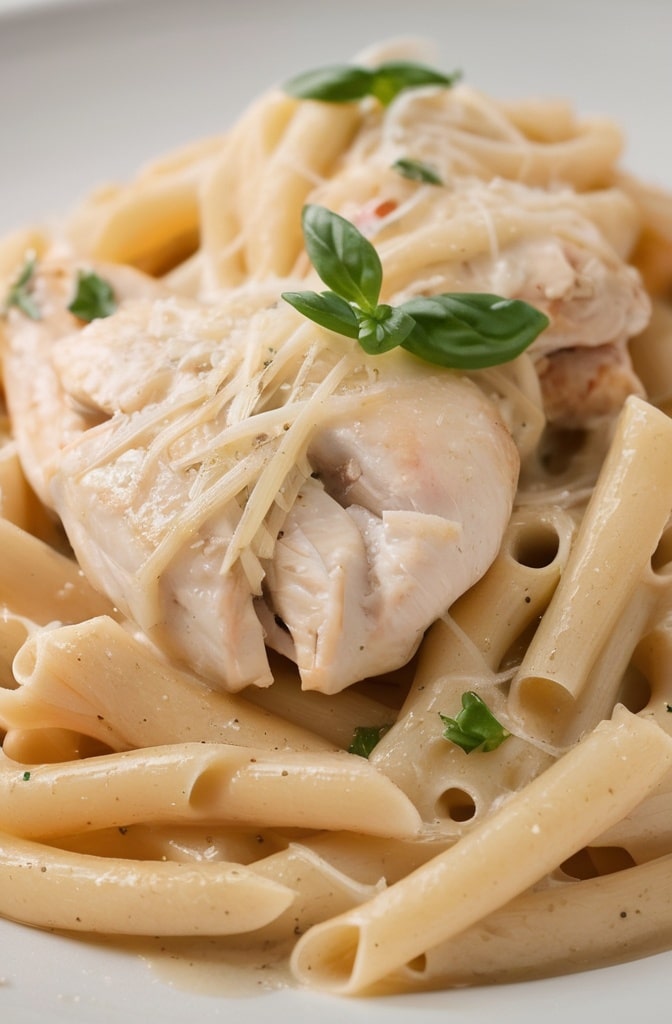
Italian chicken pasta isn’t just food; it’s cultural heritage transformed into nourishment. Unlike many Americanized versions that favor excess, authentic Italian chicken pasta celebrates balance—each element dancing harmoniously with the others. The chicken should complement the pasta, not overwhelm it. The sauce should enhance, not drown. This delicate balance is what separates a good pasta dish from one that transports you straight to an Italian countryside.
1. Ingredients & Substitutions
For the Pasta:
- 400g (14oz) pasta (preferably pappardelle, fettuccine, or rigatoni)
- Sea salt for pasta water (about 2 tablespoons)
When choosing pasta, texture matters enormously. Artisanal bronze-die pasta has a rougher surface that sauce clings to beautifully. If your watching carbs, zucchini noodles can substitute, but they’ll release water, so adjust your sauce consistency accordingly.
For the Chicken:
- 500g (1.1lbs) chicken thighs, boneless and skinless
- 2 tablespoons extra virgin olive oil
- 3 cloves garlic, thinly sliced (not minced—this is crucial)
- 1 teaspoon sea salt
- Freshly ground black pepper
- 1 tablespoon fresh rosemary, finely chopped
- 1 tablespoon fresh thyme
Chicken thighs are non-negotiable here—they simply carry more flavor than breast meat and won’t dry out. If you absolutely must use chicken breast, brine it first (30 minutes in saltwater) to help maintain moisture. Heritage-breed chickens will elevate this dish considerably, if you can source them.
For the Sauce:
- 3 tablespoons extra virgin olive oil (Tuscan or Sicilian preferred)
- 1 medium onion, finely diced
- 2 carrots, finely diced
- 2 stalks celery, finely diced (creating a proper soffritto)
- 4 cloves garlic, thinly sliced
- 1 cup dry white wine (Pinot Grigio or Vermentino)
- 800g (28oz) San Marzano tomatoes, crushed by hand
- 1 teaspoon red pepper flakes (adjust to taste)
- 1 tablespoon tomato paste
- 1 bay leaf
- 1 parmesan rind (optional but transformative)
- Salt and freshly ground black pepper to taste
For the wine, you needn’t use your finest bottle, but please use something you’d actually drink. Cooking wine is an abomination in Italian cuisine. No San Marzano tomatoes available? Mutti or Bianco DiNapoli are excellent alternatives.
For Finishing:
- Fresh basil leaves, torn (not chopped—tearing releases more aroma)
- Freshly grated Parmigiano-Reggiano (aged 24+ months)
- Extra virgin olive oil for drizzling
- Freshly ground black pepper
Pre-grated cheese is a mortal sin in italian cooking. The flavor compounds begin deteriorating the moment cheese is grated, so always grate just before serving.
2. Step-by-Step Instructions
Preparing the Chicken:
- Cut chicken thighs into 1-inch pieces. Pat them dry with paper towels—this is essential for proper browning. Season generously with salt, pepper, rosemary, and thyme, then let sit for 20 minutes to absorb flavors.
- Heat olive oil in a large, heavy-bottomed pan until shimmering but not smoking. A cast-iron skillet works beautifully here, but any heavy pan will do. Add the chicken pieces without overcrowding (work in batches if needed) and sear until golden brown on all sides, about 3-4 minutes per side.
- When chicken is nearly done, add sliced garlic to the pan and cook for just 30 seconds until fragrant. Be vigilent here—garlic burns in seconds and will ruin the entire dish with bitterness. Remove chicken and garlic mixture from pan and set aside.
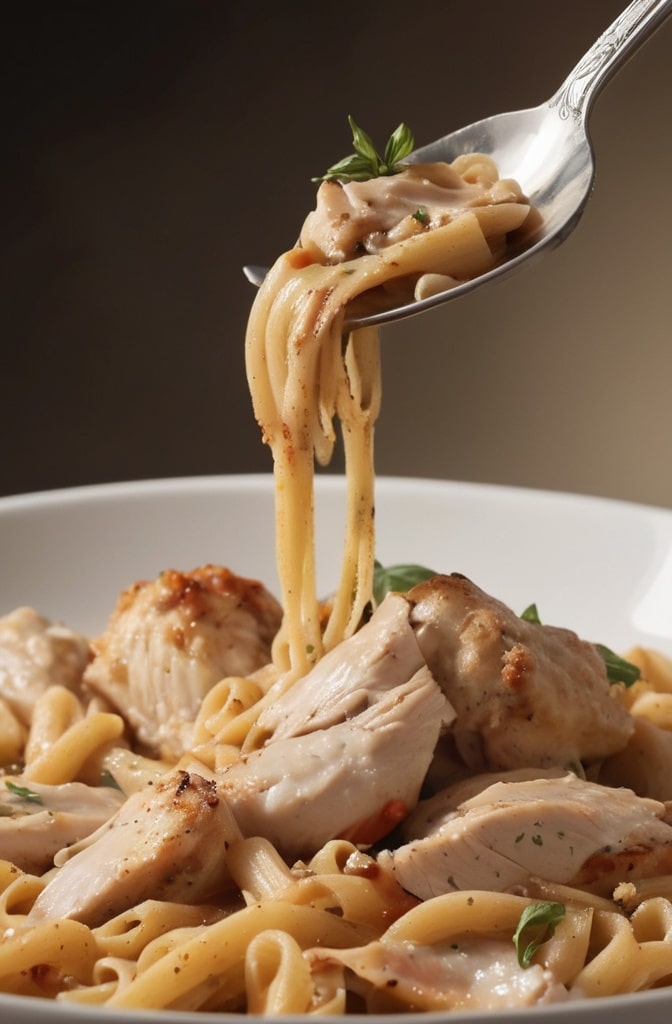
The most common mistake at this stage is moving the chicken too much. Let it develop a proper crust before flipping. Patience here pays dividends in flavor later.
Creating the Sauce:
- In the same pan (don’t you dare wash it—those brown bits are flavor gold), add olive oil and heat gently. Add onions, carrots, and celery with a pinch of salt to create your soffritto. Cook over medium-low heat for 10-12 minutes until vegetables are soft and onions are translucent. This is the flavor foundation—don’t rush this step!
- Add sliced garlic and red pepper flakes, cooking for 60 seconds until fragrant. Pour in white wine and increase heat to medium-high, scraping all those beautiful browned bits from the bottom of the pan. Let the wine reduce by half, approximately 3-4 minutes.
- Add hand-crushed tomatoes, tomato paste, bay leaf, and parmesan rind if using. Reduce heat to low and simmer uncovered for 25-30 minutes, stirring occasionally. The sauce should thicken slightly and develop deeper flavors. Season with salt and pepper to taste.
If your sauce seems too watery, be patient. Reducing slowly preserves the bright tomato flavor better than aggressive boiling. If it’s too thick, add a splash of pasta water.
Cooking the Pasta:
- Bring a large pot of water to a rolling boil. Add salt until it tastes like seawater—about 2 tablespoons per 4 liters of water. This isn’t just tradition; properly salted water seasons the pasta from within.
- Cook pasta until very al dente—about 2 minutes less than package instructions. It will finish cooking in the sauce. Reserve 1 cup of pasta water before draining.
- Do not rinse the pasta—ever! The starch on the surface is crucial for sauce adhesion.
The pasta water is liquid gold. The starch it contains will help emulsify your sauce and create that silky texture that distinguishes restaurant-quality pasta.
Bringing It All Together:
- Return the chicken and any accumulated juices to the sauce. Simmer together for 2-3 minutes to meld flavors.
- Add the drained pasta directly to the sauce along with 1/4 cup of pasta water. Toss gently over medium-low heat for about 2 minutes, allowing the pasta to absorb some sauce and finish cooking. Add more pasta water if needed to maintain a silky consistency.
- Remove from heat and fold in half the torn basil leaves. The residual heat will release their essential oils without blackening them.
Resist the urge to add cheese to the whole pot—it can clump and become stringy. Instead, finish individual portions with freshly grated cheese.
3. Cooking Techniques & Science
The magic of this dish lies in several key techniques that might seem subtle but create profound differences in the final result. Browning the chicken creates a Maillard reaction—a chemical process that produces hundreds of flavor compounds. This is why proper searing (and not moving the chicken too soon) is so important.
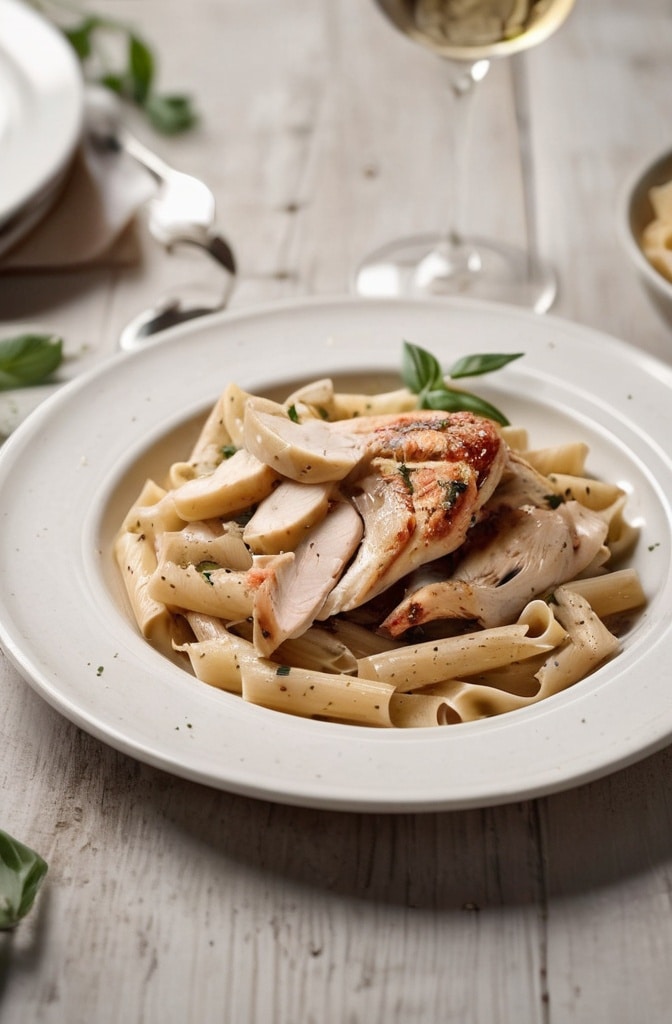
The soffritto (diced onion, carrot, celery) serves as more than just aromatic vegetables. When cooked slowly, their natural sugars caramelize, creating a depth of flavor that forms the backbone of the sauce. The Italian soffritto is similar to the French mirepoix or Spanish sofrito—it’s a technique dating back centuries and appears across Mediterranean cuisines.
Adding pasta directly to the sauce rather than plating separately allows the starchy pasta to absorb the sauce’s flavors while releasing starches that thicken and emulsify the sauce. This is why restaurant pasta often tastes more cohesive than home versions where sauce is simply ladled over pasta.
The parmesan rind contains concentrated glutamates—natural flavor enhancers similar to MSG but completely natural. As it simmers in the sauce, it slowly dissolves, releasing these compounds and creating that elusive umami that makes people crave more.
4. Serving & Pairing Suggestions
Serve this glorious creation in warmed bowls—cold plates will rapidly cool your pasta and congeal the sauce, diminishing both texture and flavor. A shallow bowl works best, alowing the pasta to spread slightly rather than stacking, which compresses it.
Finish each portion with a generous grating of Parmigiano-Reggiano, a scatter of remaining fresh basil, and a light drizzle of your finest extra virgin olive oil. The heat of the pasta will release the oil’s aromatic compounds, creating an additional layer of flavor and aroma.
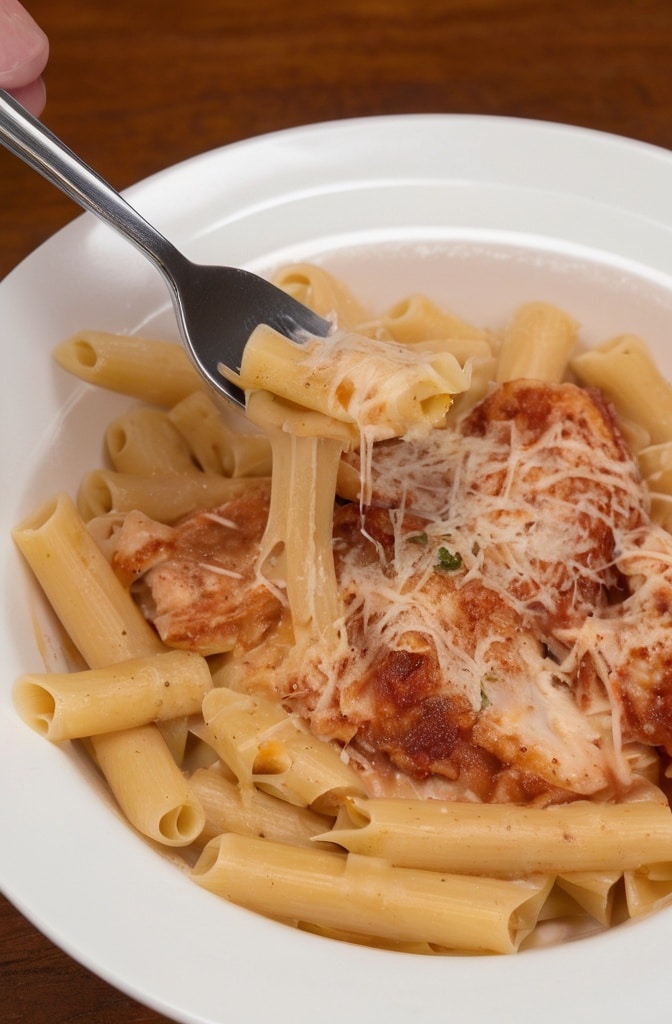
This dish pairs magnificently with a medium-bodied Italian red wine such as Chianti Classico or Montepulciano d’Abruzzo. The acidity in these wines cuts through the richness of the sauce while complementing the tomato’s natural acidity. If you prefer white, a full-bodied Vermentino from Liguria stands up beautifully.
For a complete meal, serve with a simple bitter greens salad dressed with lemon juice and olive oil—the bitterness and acidity will cleanse the palate between bites. A small piece of crusty ciabatta for sauce-mopping is permissable, though purists might disagree.
5. Variations Worth Exploring
While the classic version above is my personal favorite, several regional variations deserve mention:
Sicilian-Style: Add 2 tablespoons of capers, 1/4 cup olives, and a pinch of cinnamon to the sauce for a punchy Mediterranean profile influenced by centuries of Arab rule.
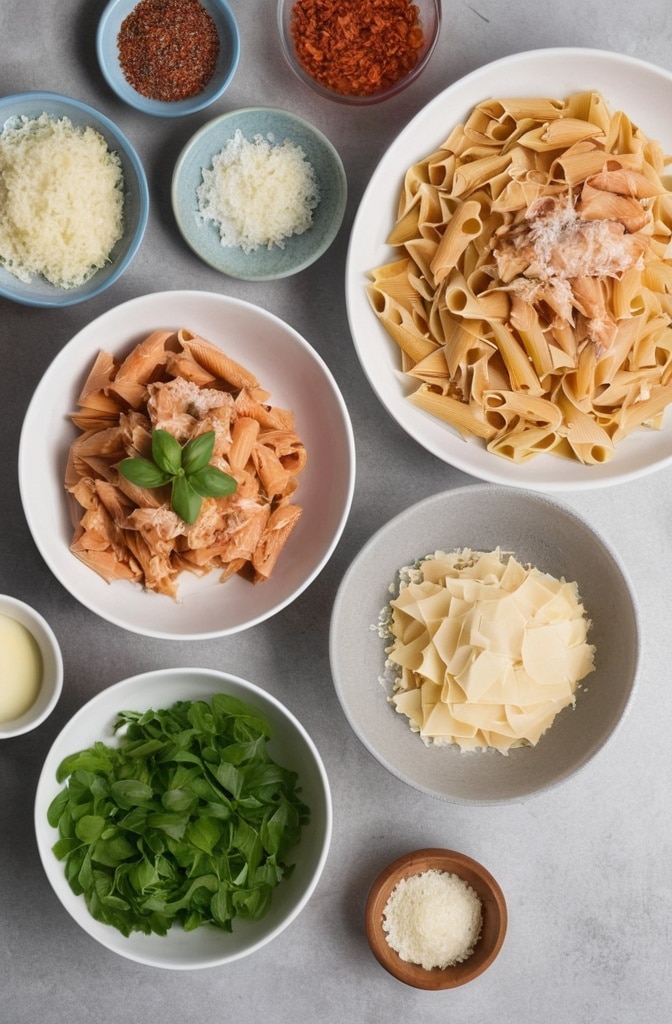
Northern Italian: Replace tomato sauce with a white wine cream reduction, add sautéed mushrooms, and finish with fresh tarragon instead of basil for an Alpine interpretation.
Tuscan Twist: Add chopped cavolo nero (black kale) to the sauce during the last 5 minutes of simmering and incorporate a handful of toasted pine nuts before serving.
Each variation maintains the soul of the dish while exploring different regional Italian flavor profiles. Experiment, but remember that Italian cooking celebrates restraint—each additional ingredient should earn its place.
Conclusion
Italian chicken pasta, when prepared with attention to detail and respect for ingredients, transcends its humble components. The techniques—proper browning, slow-building flavors, and pasta-sauce marriage—matter far more than elaborate ingredients or complicated steps.
The beauty of this dish lies in its adaptability while maintaining its essential character. Whether you have access to the finest San Marzano tomatoes or must make do with what’s available at your local market, understanding the principles behind each step allows you to create something authentic and deeply satisfying.
Remember that Italian cooking is as much philosophy as technique—it celebrates simplicity, quality ingredients, and the joy of shared meals. When someone asks for seconds of your chicken pasta, you’ll know you’ve captured something of that spirit.
Frequently Asked Question?
Can I make this dish ahead of time?
You can prepare the sauce and chicken up to two days in advance—in fact, many chefs believe tomato-based sauces improve after a day in the refrigerator as flavors meld. However, always cook pasta fresh just before serving. Reheat the sauce gently, adding a splash of water if needed, then proceed with the final pasta cooking and combining steps.
My sauce seems acidic. How can I balance it?
Tomato acidity varies widely by brand and season. If your sauce tastes too acidic, add 1/2 teaspoon of baking soda, which will neutralize acid without affecting flavor (unlike sugar, which masks acidity but adds sweetness). Another traditional remedy is to add a small, grated carrot to the sauce, which contains natural sugars that balance acidity.
Can I use different herbs?
Absolutely, but with intention. Oregano offers a more rustic, southern Italian profile. Marjoram brings delicate sweetness. Tarragon creates a French-Italian fusion with its anise notes. Whatever you choose, always add woody herbs (rosemary, thyme) early and delicate herbs (basil, parsley) at the end.
How do I know when pasta is perfectly al dente?
The Italian expression is “al dente” means “to the tooth”—pasta should offer slight resistance when bitten. For this recipe, you want even firmer pasta initially since it will continue cooking in the sauce. The only reliable method is tasting—package times are merely guidelines and vary widely by brand, water volume, and even altitude.
Is there a vegetarian version of this dish?
Replace chicken with 400g of mixed mushrooms (porcini, cremini, and oyster work wonderfully together). Brown them in the same way, cooking until their water releases and evaporates, then develops fond. Mushrooms contain natural glutamates that mimic meat’s umami qualities. Add 1 tablespoon of nutritional yeast to the sauce for additional depth.
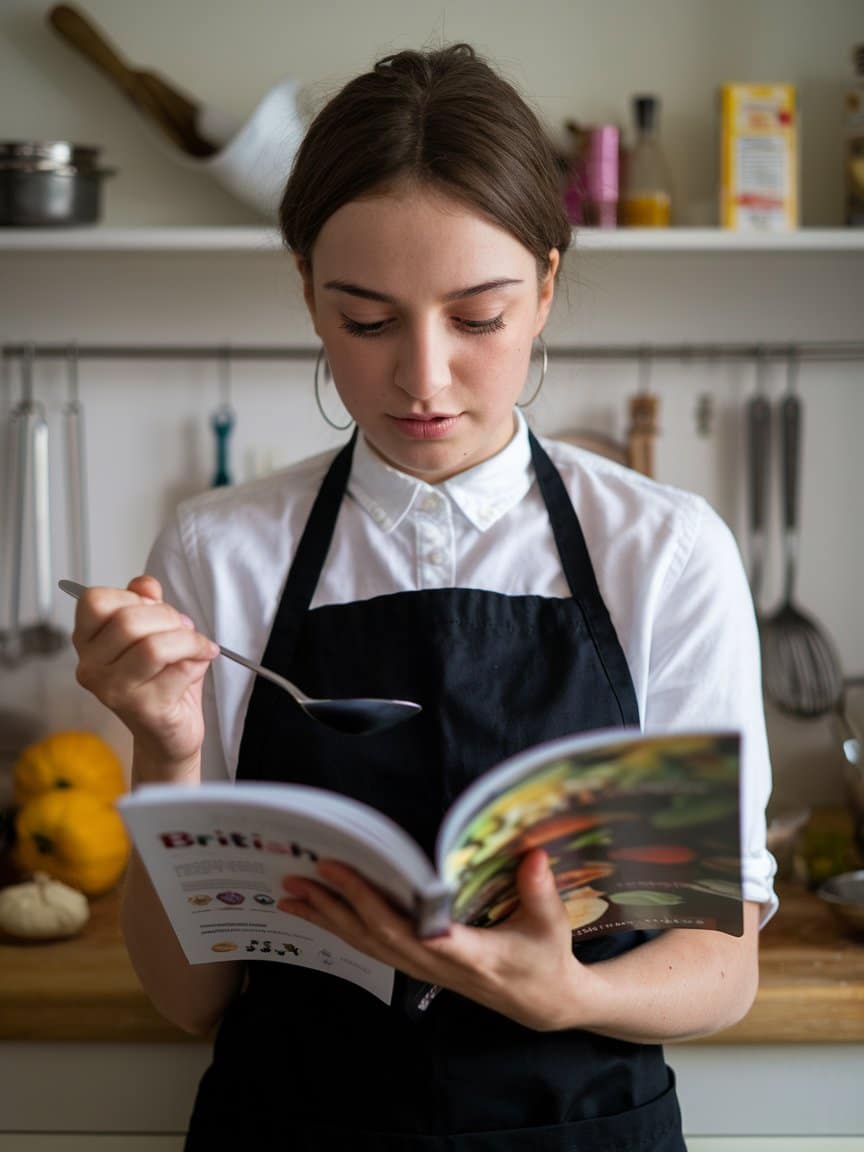
Veronica is a passionate food enthusiast with over three years of experience in exploring and writing about diverse cuisines. Her expertise lies in reviewing restaurants, sharing creative recipes, and discovering the latest food trends. As the voice behind FoodieRecap.com, Anju brings fresh perspectives and culinary insights to her audience.
